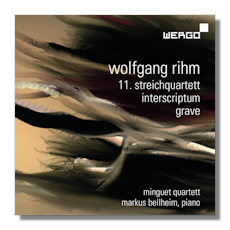
The Internet's Premier Classical Music Source
Related Links
- Rihm Reviews
- Latest Reviews
- More Reviews
-
By Composer
-
Collections
DVD & Blu-ray
Books
Concert Reviews
Articles/Interviews
Software
Audio
Search Amazon
Recommended Links
Site News
 CD Review
CD Review
Wolfgang Rihm

- String Quartet #11
- Interscriptum *
- Grave
* Marcus Bellheim, piano
Minguet Quartet
Wergo WER6756-2
Wolfgang Rihm was born in 1952. His compositions are in some ways hard to characterize. They are not unconventional or always particularly experimental. But neither do they cover entirely familiar ground. This is particularly true of his chamber music. Here is a pleasing new CD from Wergo of Rihm's four movement eleventh String Quartet, which was written between 1998 and 2010. The disk also contains a "Duo" for string quartet and piano, Interscriptum (2000/2002), and a single movement for string quartet written in memory of Thomas Kakuska, Grave (2005). The latter two pieces last under and about half as long as the main work respectively.
Time, duration and pace are important. The impact of the first movement of the String Quartet, for instance, comes in no small part from the fact that it begins moderato. It also begins in an almost elegiac, tonal way; and rapidly develops into a musical world that sounds as though it's much more disparate and centrifugal.
Begun in 1998 for the Takács, this quartet caused Rihm difficulties which he only resolved in two bouts of work on it in 2004 and a further six years after that, in 2010. Although remaining a work of great contrast, the Eleventh String Quartet is in no way fragmented or discontinuous. And the Minguets play it in the spirit which it needs: of variety and indeed contrast. Even within single movements… the longest first movement for instance. That goes from relaxed to agitated, seemingly confident and "coping", to anguished and almost emotionally distressed. So the one quality which the members of the quartet, who have been together since 1988, accentuate is tension. Their tempi and sense of movement, though, arise from the melody and harmony; not from any idea that Rihm needs to have gruffly cauterized distress mapped onto his music for effect. The phrasing in each of the movements seems as much like the knowledgable conversation of an expert rather than the enthusiastic agitation of a novice.
The Quartet is a substantial work. It explores much ground and uses multiple strong techniques with which the Minguets are well in tune. Where melodiousness is needed (as at the start of the lento second movement – also redolent of Beethoven, as is the start of the allegro con fuoco third of Tippett), their style is gently melodic. But they achieve the more bitter or astringent moods equally convincingly. Although there is a realism, almost an earthiness, to their playing, which is closely miked.
Interscriptum is a much more angular piece than even the string quartet's most aggressive moments. Although it pointedly starts and ends in slowness and quiet, it's punctuated with new ideas and motives at the same time as there are extended runs on one or other of the five instruments as they seem to explore – yet delight in gathering sporadically to "discuss" – the corners of the room which they inhabit. For Rihm is at pains to set limits and boundaries. Perhaps the most remarkable aspect of this piece is the way in which the composer sustains its energy over fifteen minutes, which hardly let up, and yet are varied in texture and harmony.
Although the conceptual center of gravity of the slightly longer Grave is quiet and rest, it too is interrupted by sharper moments and interludes. These have their own logic and serve actually to support and emphasize the work's sense of stasis. Although the microscope under which the minutiae of music played almost in slow motion at times could over-expose the sounds and mechanics of the strings, this is not Rihm's intention in grave; nor indeed in any of his works. It's the result, the way the components work together, that matters. Yet again the Minguets work completely in accord with this intention and throw all the light on the totality of the composition, rather than its unfolding or its purely sonic elements.
That approach of performance style is just what is needed. Rihm's is hard music to pin down. But the players on this CD are well enough aware of the composer's intents not to let such a distraction work against the production of coherence, unity and a compelling end-result. The temptation would have been to impose an all too linear exposition from beginning to end. That's avoided. Their playing delves into each change in dynamic and articulation, producing tension as well as forward movement, a lingering over interesting tension in addition to a sense of urgency. The contrasts within Grave, which is perhaps the most satisfying of the three works on the CD, illustrate this skill well: their technique immediately allows us to feel how firm are the hands we're in. Yet never draws attention to itself. We forget the intricacies and subtleties of the score in favor of its contours and sense of development.
The acoustic, the Deutschland Kammermusiksaal in Cologne, is dry and warm. It may lack a little responsiveness to some listeners seeking perhaps more of a sense of performance and sound; but it certainly directs our attention to Rihm's musical ideas, which are always worth following. The booklet has helpful background and actually contains some extracts from the score – although a little too small to read easily. If you enjoy Rihm's music, you'll want to get this attractive CD, which has to be considered as as typical of this interesting and lively composer's current musical development as any other.
Copyright © 2013, Mark Sealey





















